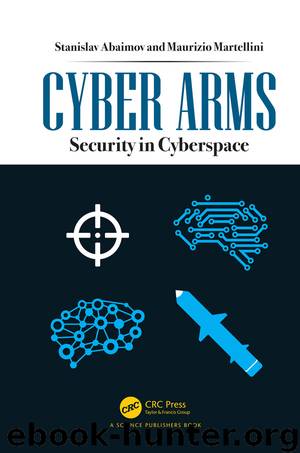Cyber Arms; Security in Cyberspace by Stanislav Abaimov; Maurizio Martellini

Author:Stanislav Abaimov; Maurizio Martellini
Language: eng
Format: epub
Publisher: CRC Press
Published: 2020-07-13T16:00:00+00:00
2.5.2 Vulnerabilities of Nuclear Weapon Systems and N3C
Today’s NSA secrets become tomorrow’s Ph.D. theses and the next day’s hacker tools
Bruce Schneier
Nuclear Weapons Overview
Nuclear weapons, enhanced by computerized systems, are becoming more dependent on virtual intelligence. Though ensuring the greatest deterrence of all time, with their increased complexity and embedded cyber equipment, they have become vulnerable to stealthy, high speed, unpredictable and anonymous cyberattacks and have expanded the range of attack vectors.
Nuclear weapon means any weapon that derives its destructive force from nuclear reactions. The nuclear reaction may either be fission or a combination of fission and fusion. Nuclear weapons are considered weapons of mass destruction.72
72 Nuclear Weapon Law and Legal Definition, last retrieved on 9 December 2018 at https://definitions.uslegal.com/n/nuclear-weapon/
Cyberattacks on the Nuclear Command, Control, and Communications (NC3) systems could cause false alarms, interrupt critical communications, interfere with the delivery systems, or even lead to full control of a nuclear weapon, targeted launch or detonation within the silo.
It is widely believed that the nuclear systems have the safest design and highest level of protection. However, the human factor remains present and human errors and unauthorized use with the systems, neither can be excluded with errors in design, calculations or equipment failures. Even previously secure air-gapped solutions are no longer the guarantee of protection from cyberattacks.73
73 S. Abaimov and P. Ingram, Hacking UK Trident: The Growing Threat, British-American Security Information Council 2017
There are a number of vulnerabilities and pathways through which a malicious actor may infiltrate a nuclear weapons system without a state’s knowledge. Human error, system failures, design vulnerabilities, and susceptibilities within the supply chain all represent common security issues in nuclear weapons systems. Cyberattack methods such as data manipulation, digital jamming and cyber spoofing could jeopardize the integrity of communication, leading to increased uncertainty in decision-making.74
74 Cybersecurity of Nuclear Weapons Systems Threats, Vulnerabilities and Consequences, Beyza Unal and Patricia Lewis, January 2018, International Security Department, Chatham House, last retrieved on 2 August 2018 at https://www.chathamhouse.org/sites/default/files/publications/research/2018-01-11-cybersecurity-nuclear-weapons-unal-lewis-final.pdf
Cybersecurity of Nuclear Weapons Systems Threats, Vulnerabilities and Consequences, Beyza Unal and Patricia Lewis, Chatham House, 2018
Recognizing the need of the nuclear systems for peaceful purposes, existence and the continuing production of nuclear weapons and their support equipment for military deterrence, the issue of their protection from sophisticated cyber threats is becoming one of paramount importance.
Hackers are targeting nuclear facilities, homeland security dept. and F.B.I. say75
75 N. Perlroth, Hackers are targeting nuclear facilities, 6 July 2017, last retrieved on 1 June 2018 at https://www.nytimes.com/2017/07/06/technology/nuclear-plant-hack-report.html?_r=0
Since May 2017, hackers have been penetrating the computer networks of companies that operate nuclear power stations and other energy facilities, as well as manufacturing plants in the United States and other countries.
Among the companies targeted was the Wolf Creek Nuclear Operating Corporation, which runs a nuclear power plant near Burlington, Kan., according to security consultants and an urgent joint report issued by the Department of Homeland Security and the Federal Bureau of Investigation last week.
Information about cyberattacks on nuclear systems is very sensitive and mostly classified, and not available openly. However, it
Download
This site does not store any files on its server. We only index and link to content provided by other sites. Please contact the content providers to delete copyright contents if any and email us, we'll remove relevant links or contents immediately.
Effective Threat Investigation for SOC Analysts by Yahia Mostafa;(6608)
Practical Memory Forensics by Svetlana Ostrovskaya & Oleg Skulkin(6331)
Machine Learning Security Principles by John Paul Mueller(6299)
Attacking and Exploiting Modern Web Applications by Simone Onofri & Donato Onofri(5976)
Operationalizing Threat Intelligence by Kyle Wilhoit & Joseph Opacki(5934)
Solidity Programming Essentials by Ritesh Modi(4055)
Microsoft 365 Security, Compliance, and Identity Administration by Peter Rising(3696)
Operationalizing Threat Intelligence by Joseph Opacki Kyle Wilhoit(3425)
Mastering Python for Networking and Security by José Manuel Ortega(3358)
Future Crimes by Marc Goodman(3351)
Mastering Azure Security by Mustafa Toroman and Tom Janetscheck(3337)
Blockchain Basics by Daniel Drescher(3307)
Learn Computer Forensics - Second Edition by William Oettinger(3185)
Incident Response with Threat Intelligence by Roberto Martínez(2912)
Mobile App Reverse Engineering by Abhinav Mishra(2889)
Mastering Bitcoin: Programming the Open Blockchain by Andreas M. Antonopoulos(2873)
The Code Book by Simon Singh(2832)
Building a Next-Gen SOC with IBM QRadar: Accelerate your security operations and detect cyber threats effectively by Ashish M Kothekar(2791)
From CIA to APT: An Introduction to Cyber Security by Edward G. Amoroso & Matthew E. Amoroso(2785)
